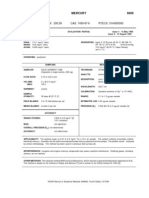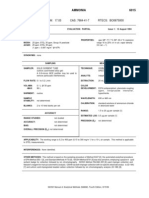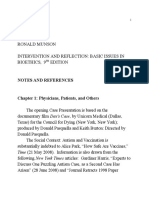Ca MW: Table 1 CAS: Table 1 RTECS: Table 1: CALCIUM and Compounds, As Ca 7020
Ca MW: Table 1 CAS: Table 1 RTECS: Table 1: CALCIUM and Compounds, As Ca 7020
Uploaded by
Harold Alonso CFCopyright:
Available Formats
Ca MW: Table 1 CAS: Table 1 RTECS: Table 1: CALCIUM and Compounds, As Ca 7020
Ca MW: Table 1 CAS: Table 1 RTECS: Table 1: CALCIUM and Compounds, As Ca 7020
Uploaded by
Harold Alonso CFOriginal Description:
Original Title
Copyright
Available Formats
Share this document
Did you find this document useful?
Is this content inappropriate?
Copyright:
Available Formats
Ca MW: Table 1 CAS: Table 1 RTECS: Table 1: CALCIUM and Compounds, As Ca 7020
Ca MW: Table 1 CAS: Table 1 RTECS: Table 1: CALCIUM and Compounds, As Ca 7020
Uploaded by
Harold Alonso CFCopyright:
Available Formats
CALCIUM and compounds, as Ca 7020
Ca MW: Table 1 CAS: Table 1 RTECS: Table 1
METHOD: 7020, Issue 2 EVALUATION: FULL Issue 1: 15 February 1984
Issue 2: 15 August 1994
OSHA : Table 1 PROPERTIES: soft, reactive metal; valence 2;
NIOSH: Table 1 MP 848 °C; VP not significant
ACGIH: Table 1
SYNONYMS: Quicklime (CaO); limestone (CaCO 3 ); marble (CaCO 3 ); hydrated lime (Ca(OH) 2 )
SAMPLING MEASUREMENT
SAMPLER: FILTER TECHNIQUE: ATOMIC ABSORPTION, FLAME
(0.8-µm cellulose ester membrane)
ANALYTE: calcium
FLOW RATE: 1 to 3 L/min
ASHING: conc. HNO 3 , 6 mL; 140 °C
VOL-MIN: 20 L @ 5 mg/m 3 60% (w/v) HClO 4 , 2 mL; 400 °C
-MAX: 400 L
FINAL
SHIPMENT: routine SOLUTION: 5% HCl; 100 mL
1000 µg/mL Cs; 1000 µg/mL La
SAMPLE
STABILITY: stable FLAME: air-acetylene, reducing
BLANKS: 2 to 10 field blanks per set WAVELENGTH: 422.7 nm
BACKGROUND
CORRECTION: none used
ACCURACY CALIBRATION: Ca 2+ in 5% HCl
RANGE STUDIED: 2.6 to 10.2 mg/m 3 [1] RANGE: 0.08 to 1.7 mg per sample [2]
(85-L samples)
ESTIMATED LOD: 0.001 mg per sample [3]
BIAS: - 0.39%
OVERALL PRECISION (ŜrT): 0.063 [1] PRECISION (Sr): 0.02 [1,3]
ACCURACY: ± 11.5%
APPLICABILITY: The working range is 1 to 20 mg/m 3 for an 85-L air sample. This is an elemental analysis, not compound
specific. Verify that the compounds in the samples are soluble with the ashing procedure. Aliquots of the samples can be
analyzed separately for many additional metals.
INTERFERENCES: The use of 1000 µg/mL Cs controls ionization in the flame caused by metals such as Na, K, Li, and Mg. The
presence of Si, Al, or H 3 PO 4 require the use of 1% (w/w) La as a releasing agent.
OTHER METHODS: This method combines and replaces P&CAM 173 [4] and S205 [2]. Method 7300 (ICP-AES) is an alternate
analytical method.
NIOSH Manual of Analytical Methods (NMAM), Fourth Edition, 8/15/94
CALCIUM and compounds, as Ca: METHOD 7020, Issue 2, dated 15 August 1994 - Page 2 of 4
REAGENTS: EQUIPMENT:
1. Nitric acid, conc. 1. Sampler: cellulose ester membrane filter,
2. Hydrochloric acid, conc. 0.8-µm pore size, 37-mm diameter; in cassette
3. Hydrochloric acid, 5% (v/v). Add 50 mL conc. filter holder.
HCl to 500 mL water; dilute to 1 L. 2. Personal sampling pump, 1 to 3 L/min, with
4. Calibration stock solution, 1000 µg Ca/mL. flexible connecting tubing.
Commercially available or add 50 mL 3. Atomic absorption spectrophotometer with an
deionized water and minimum volume of HCl air-acetylene burner head and calcium hollow
(20 mL) to dissolve 2.498 g CaCO 3. Dilute to cathode lamp.
1 L with deionized water. 4. Regulators, 2-stage, for air and acetylene.
5. Cs solution, 50 mg/mL. Dissolve 73.40 g 5. Beakers, Phillips, 125-mL, or Griffin, 50-mL,
CsNO 3 in water to make 1 L solution. with watchglass covers.*
6. La solution, 50 mg/mL. Dissolve 156 g 6. Volumetric flasks, 25- and 100-mL.*
La(NO 3)3·6H 2O in water to make 1 L solution. 7. Micropipets, 5 to 500 µL.*
7. Distilled or deionized water. 8. Hotplate, surface temperature 140 and
8. Air, filtered. 400 °C.
9. Acetylene.
10. Perchloric acid, 60% w/v.
* Clean with conc. HNO 3 and rinse
* See SPECIAL PRECAUTIONS. thoroughly with distilled or deionized water
before use.
SPECIAL PRECAUTIONS: Perform all perchloric acid digestions in a perchloric acid fume hood.
SAMPLING:
1. Calibrate each personal sampling pump with a representative sampler in line.
2. Sample at an accurately known flow rate between 1 and 3 L/min for a total sample size of 20 to
400 L. Do not exceed 2 mg total dust loading on the filter.
SAMPLE PREPARATION:
NOTE: The following sample preparation gave quantitative recovery (see EVALUATION OF
METHOD). Steps 4 through 9 of Method 7300 or other quantitative ashing techniques
may be substituted, especially if several metals are to be determined on a single filter.
3. Open the cassette filter holders and transfer the samples and blanks to separate clean beakers.
4. Add 5 mL conc. HNO 3 and cover with a watchglass. Start reagent blanks at this point.
5. Heat on hotplate (140 °C) until most of the acid has evaporated.
6. Add 2 mL conc. HNO 3 and 1 mL 60% HClO 4.
7. Heat on 400 °C hotplate until dense fumes of perchloric acid appear.
8. Remove watchglass and rinse into the beaker with distilled water.
9. Place the beakers on the 400 °C hotplate and allow to go to dryness.
10. Cool each beaker and dissolve the residues in 5 mL 5% HCl.
11. Transfer the solution quantitatively to a 100-mL volumetric flask containing 2 mL of 50 mg/mL
Cs solution and 2 mL of 50 mg/mL La solution.
NOTE: Dilute to a smaller volume (e.g., 10 mL) with proportionally less Cs and La if required for
sensitivity of analysis for other metals in the sample.
12. Dilute to volume with 5% HCl.
NIOSH Manual of Analytical Methods (NMAM), Fourth Edition, 8/15/94
CALCIUM and compounds, as Ca: METHOD 7020, Issue 2, dated 15 August 1994 - Page 3 of 4
CALIBRATION AND QUALITY CONTROL:
13. Add known amounts, covering the range 0 to 500 µg Ca per sample, of calibration stock
solution to 100-mL volumetric flasks containing 2 mL each of the 50 mg/mL Cs and La solutions
and dilute to volume with 5% HCl.
14. Analyze the working standards along with the samples and blanks (steps 19 and 20).
15. Prepare a calibration graph of absorbance vs. solution concentration (µg/mL).
16. Aspirate a standard for every 10 samples to check instrument drift.
17. Check recoveries with at least one spiked media blank per 10 samples.
18. Use method of additions occasionally to check for interferences.
MEASUREMENT:
19. Set spectrophotometer according to manufacturer's recommendations and to conditions on
page 7020-1.
20. Aspirate standards and samples. Record absorbance readings.
NOTE: If the absorbance values for the samples are above the linear range of the standards,
dilute the solutions with 5% HCl and an appropriate amount of the 50 mg/mL Cs and La
solutions, reanalyze, and apply the appropriate dilution factor in the calculations.
CALCULATIONS:
21. Using the measured absorbances, calculate the corresponding concentrations (µg/mL) of
calcium in the sample, C s, and average media blank, C b, from the calibration graph.
22. Using the solution volumes (mL) of the sample, V s, and media blanks, V b, calculate the
concentration, C (mg/m 3), of calcium in the volume of air sampled, V (L):
EVALUATION OF METHOD:
Method S205 [2] was issued on September 26, 1975, and validated over the range 2.6 to 10.2 mg/m 3
using an 85-L air sample by lab testing with spiked filters and generated atmospheres of CaO, verified
by EDTA titration [1]. Collection efficiency of 1.00 was determined for the sampling device. Precision
and accuracy data are given on page 7020-1. An additional check showed an estimated LOD of 1 µg
Ca per sample [3].
REFERENCES:
[1] Documentation of the NIOSH Validation Tests, S205, U.S. Department of Health, Education, and
Welfare, Publ. (NIOSH) 77-185 (1977).
[2] V. 3, S205, U.S. Department of Health, Education, and Welfare, Publ. (NIOSH) 77-157-C (1979).
[3] User check, UBTL, NIOSH Seq. #3990-Q (unpublished, November 29, 1983).
[4] Ibid, NIOSH Manual of Analytical Methods, 2nd ed., Vol. 5, P&CAM 173, U.S. Department of Health,
Education, and Welfare, Publ. (NIOSH) 79-141 (1979).
METHOD REVISED BY:
Mark Millson, NIOSH/DPSE and R. DeLon Hull, Ph.D., NIOSH/DBBS; S205 originally validated under
NIOSH Contract CDC-99-74-45.
NIOSH Manual of Analytical Methods (NMAM), Fourth Edition, 8/15/94
CALCIUM and compounds, as Ca: METHOD 7020, Issue 2, dated 15 August 1994 - Page 4 of 4
TABLE 1: General Information
FORMULA M.W. CAS # RTECS # EXPOSURE LIMITS (mg/m 3)
OSHA NIOSH ACGIH
Ca 40.08 7440-70-2 EV8040000 -- -- --
CaO 56.08 1305-78-8 EW3100000 5 2 2
Ca(OH) 2 74.10 1305-62-0 EW2800000 None 5 5
Ca(CO 3)2 100.09 471-34-1 EV9580000 15 (total); 10 (total); 10
total dust 5 (resp.) 5 (resp.)
NIOSH Manual of Analytical Methods (NMAM), Fourth Edition, 8/15/94
You might also like
- On The Reddish Glittery Mud The Inca Use PDFDocument15 pagesOn The Reddish Glittery Mud The Inca Use PDFPeter Carroll100% (1)
- Test Plan Common Rail InjectorsDocument76 pagesTest Plan Common Rail Injectorslennon r100% (3)
- Niosh 6009 PDFDocument5 pagesNiosh 6009 PDFCaleb ConnerNo ratings yet
- Al MW: 26.98 (Al) CAS: 7429-90-5 (Al) RTECS: BD0330000 101.96 (Al 0) 1344-28-1 (Al 0) BD1200000Document4 pagesAl MW: 26.98 (Al) CAS: 7429-90-5 (Al) RTECS: BD0330000 101.96 (Al 0) 1344-28-1 (Al 0) BD1200000Huu Thanh NguyenNo ratings yet
- NIOSH 7900 Arsenico As PDFDocument3 pagesNIOSH 7900 Arsenico As PDFNicolas ZeballosNo ratings yet
- NIOSH 8310 Ed 94 Metales en OrinaDocument5 pagesNIOSH 8310 Ed 94 Metales en OrinaMario Rodrigo Ramirez MesaNo ratings yet
- CH CHCH CL MW: 76.53 CAS: 107-05-1 RTECS: UC7350000: Allyl Chloride 1000Document3 pagesCH CHCH CL MW: 76.53 CAS: 107-05-1 RTECS: UC7350000: Allyl Chloride 1000Cristian Gutiérrez PeñaNo ratings yet
- Niosh 7301 PDFDocument8 pagesNiosh 7301 PDFAngelicaNo ratings yet
- Hydrogen Cyanide 6010: HCN MW: 27.03 CAS: 74-90-8 RTECS: MW6825000Document5 pagesHydrogen Cyanide 6010: HCN MW: 27.03 CAS: 74-90-8 RTECS: MW6825000Ngọc Ánh LêNo ratings yet
- Niosh 6004 Dióxido de AzufreDocument4 pagesNiosh 6004 Dióxido de AzufreEverChumpisucaAlvarezNo ratings yet
- NIOSH 6002 - PH3Document4 pagesNIOSH 6002 - PH3Minh Hằng TrầnNo ratings yet
- 6009Document5 pages6009Oktasari Dyah AnggrainiNo ratings yet
- HydrazineDocument3 pagesHydrazineSylab InstrumentsNo ratings yet
- Alkali Metal Cations Na, K, Li 7405: NIOSH Manual of Analytical Methods (NMAM), Fifth EditionDocument5 pagesAlkali Metal Cations Na, K, Li 7405: NIOSH Manual of Analytical Methods (NMAM), Fifth EditionLINDA IVON PARRADO SÁNCHEZNo ratings yet
- Niosh 2500 Metil Etil Cetona (Mek)Document4 pagesNiosh 2500 Metil Etil Cetona (Mek)EverChumpisucaAlvarezNo ratings yet
- NISOH 1401 ButanolDocument4 pagesNISOH 1401 Butanolluis norabuenaNo ratings yet
- Niosh 2555Document5 pagesNiosh 2555KayceePortsNo ratings yet
- Table 1 MW: Table 1 CAS: Table 2 RTECS: Table 2: Alcohols I 1400Document4 pagesTable 1 MW: Table 1 CAS: Table 2 RTECS: Table 2: Alcohols I 1400Cristian Gutiérrez PeñaNo ratings yet
- EPA Method 3101 PDFDocument3 pagesEPA Method 3101 PDFJalpit MardenNo ratings yet
- METHOD #: 245.2 Title: Analyte: Instrumentation: Storet NoDocument6 pagesMETHOD #: 245.2 Title: Analyte: Instrumentation: Storet NoChuquiure L. AngelNo ratings yet
- Method 130-1 1971Document5 pagesMethod 130-1 1971QwertyNo ratings yet
- Niosh 5523Document5 pagesNiosh 5523MICROLABORATORIO S.A de C.VNo ratings yet
- CH (CH) NH MW: 73.16 CAS: 109-73-9 RTECS: EO2975000: N-Butylamine 2012Document4 pagesCH (CH) NH MW: 73.16 CAS: 109-73-9 RTECS: EO2975000: N-Butylamine 2012Jayesh PanjabiNo ratings yet
- 7906 FLUORIDES Aerosol and Gas, by IC: F MW: 18.998 CAS: (HF) 7664-39-3 RTECS: (HF) MW7875000Document4 pages7906 FLUORIDES Aerosol and Gas, by IC: F MW: 18.998 CAS: (HF) 7664-39-3 RTECS: (HF) MW7875000sonecuNo ratings yet
- Niosh 6010Document5 pagesNiosh 6010Mai Trung ToànNo ratings yet
- Niosh 1405Document6 pagesNiosh 1405MICROLABORATORIO S.A de C.VNo ratings yet
- Total HardnessDocument4 pagesTotal HardnesskuochsochinNo ratings yet
- AAS - K - USGS-Method-I-3631Document2 pagesAAS - K - USGS-Method-I-3631Ahmed GwealyNo ratings yet
- NIOSH 1550 NaftasDocument6 pagesNIOSH 1550 NaftaspetrolinkinNo ratings yet
- Yodo - NIOSH 6005Document4 pagesYodo - NIOSH 6005Mario LagosNo ratings yet
- I 1020 PDFDocument2 pagesI 1020 PDFCanela Travezaño CastroNo ratings yet
- NIOSH 3502-1993 (Phenol)Document3 pagesNIOSH 3502-1993 (Phenol)apriliandiniNo ratings yet
- TOLUENE (Diffusive Sampler) 4000: C H CH MW: 92.14 CAS: 108-88-3 RTECS: XS5250000Document4 pagesTOLUENE (Diffusive Sampler) 4000: C H CH MW: 92.14 CAS: 108-88-3 RTECS: XS5250000VaninaNo ratings yet
- NIOSH 7903 - Acidos InorganicosDocument6 pagesNIOSH 7903 - Acidos InorganicosNoe Adrianzen MNo ratings yet
- Niosh 7908-Ácidos No VolátilesDocument5 pagesNiosh 7908-Ácidos No VolátilesDiegoRossoNo ratings yet
- LQ-F090 Niosh 7906Document6 pagesLQ-F090 Niosh 7906Marilu Tello PaucarNo ratings yet
- EPA Method 3101Document3 pagesEPA Method 3101skrim240No ratings yet
- NIOSH 7907 - Ácidos VolátilesDocument6 pagesNIOSH 7907 - Ácidos VolátilesjosepthfrancisNo ratings yet
- Aas HG Epa Method 2452Document6 pagesAas HG Epa Method 2452Ahmed GwealyNo ratings yet
- Niosh 1500Document8 pagesNiosh 1500MICROLABORATORIO S.A de C.VNo ratings yet
- NMAM 7302. 2014. Elements by ICP (Microwave Digestion) .Document9 pagesNMAM 7302. 2014. Elements by ICP (Microwave Digestion) .cesioNo ratings yet
- Propylene Dichloride 1013: CH CHCLCH CL MW: 112.99 Cas: 78-87-5 RTECS: TX9625000Document4 pagesPropylene Dichloride 1013: CH CHCLCH CL MW: 112.99 Cas: 78-87-5 RTECS: TX9625000Tien ThuyNo ratings yet
- The Parable of The PipelineDocument4 pagesThe Parable of The PipelineRudraNo ratings yet
- 353.2 No3, No2Document8 pages353.2 No3, No2nguyenngoc209No ratings yet
- NIOSH 1457-1994 Ethyl Acetate Udara Lingker GC FIDDocument4 pagesNIOSH 1457-1994 Ethyl Acetate Udara Lingker GC FIDFakhri MuflihNo ratings yet
- Volatile Organic Compounds, C1 To C10, Canister Method: Formula: Table 1 MW: Table 1 CAS: Table 1 RTECS: Table 1Document14 pagesVolatile Organic Compounds, C1 To C10, Canister Method: Formula: Table 1 MW: Table 1 CAS: Table 1 RTECS: Table 1Karly RodriguezNo ratings yet
- 6015 RevDocument7 pages6015 RevAdem YildirimNo ratings yet
- Copper, ULR, Porphyrin Method 8143, 02-2009, 9th EdDocument5 pagesCopper, ULR, Porphyrin Method 8143, 02-2009, 9th EdMarcTimNo ratings yet
- Formulas: Table 1 MW: Table 1 Cas: Table 1 Rtecs: Table 1: Ketones Ii 2553Document4 pagesFormulas: Table 1 MW: Table 1 Cas: Table 1 Rtecs: Table 1: Ketones Ii 2553Nicolas ZeballosNo ratings yet
- Niosh 1501Document7 pagesNiosh 1501Lucas OliveiraNo ratings yet
- Niosh 1606Document3 pagesNiosh 1606MICROLABORATORIO S.A de C.VNo ratings yet
- SM 4500 CL ChlorineDocument7 pagesSM 4500 CL ChlorineRonald Figo Torres EcheNo ratings yet
- Method 352.1Document5 pagesMethod 352.1Purna PirdausNo ratings yet
- 6010 PDFDocument5 pages6010 PDFJoshua PerryNo ratings yet
- Niosh 6013Document4 pagesNiosh 6013Frank OspinaNo ratings yet
- Niosh 7303Document6 pagesNiosh 7303amaskpalsNo ratings yet
- Standard methods for the examination of water and sewageFrom EverandStandard methods for the examination of water and sewageNo ratings yet
- Advanced Pharmaceutical analysisFrom EverandAdvanced Pharmaceutical analysisRating: 4.5 out of 5 stars4.5/5 (2)
- Acid-Base and Electrolyte Handbook for Veterinary TechniciansFrom EverandAcid-Base and Electrolyte Handbook for Veterinary TechniciansAngela Randels-ThorpNo ratings yet
- Pumps, Channels and Transporters: Methods of Functional AnalysisFrom EverandPumps, Channels and Transporters: Methods of Functional AnalysisNo ratings yet
- Application of IC-MS and IC-ICP-MS in Environmental ResearchFrom EverandApplication of IC-MS and IC-ICP-MS in Environmental ResearchRajmund MichalskiNo ratings yet
- ENSCO 8501: General InformationDocument1 pageENSCO 8501: General InformationtphsbNo ratings yet
- D0685-Maths-Paper 1Document21 pagesD0685-Maths-Paper 1Aryan SinghNo ratings yet
- Digital Camera World - Complete Photography Guide - Mastering ExposureDocument48 pagesDigital Camera World - Complete Photography Guide - Mastering ExposurePepe Nojodan NojodanNo ratings yet
- 138 241 1 SMDocument7 pages138 241 1 SMMega Nopyanti IINo ratings yet
- Parts Manual Parts Manual Parts Manual Parts Manual: Mfg. No: 196432-0070-02Document39 pagesParts Manual Parts Manual Parts Manual Parts Manual: Mfg. No: 196432-0070-02Gerardo T.R.No ratings yet
- Super Safe Sampler: Aseptic Sampling SystemDocument2 pagesSuper Safe Sampler: Aseptic Sampling SystemSebaSuarezMNo ratings yet
- Pulsar 160 NS EURO III & IV MAY18Document84 pagesPulsar 160 NS EURO III & IV MAY18dianaaguilaraltamiranoNo ratings yet
- Finger Meditations A.K.A. Mudras: Meditation L: Thumb EnergyDocument7 pagesFinger Meditations A.K.A. Mudras: Meditation L: Thumb EnergysapnakothariNo ratings yet
- Water Quality Parameters: What They Are & Why They Are ImportantDocument23 pagesWater Quality Parameters: What They Are & Why They Are ImportantAnonymous aCMaYs28No ratings yet
- Dynamic Spectrum Sharing and Multi RAT SS ORANDocument3 pagesDynamic Spectrum Sharing and Multi RAT SS ORANgoddfldkfddfvdfmvfglNo ratings yet
- Handout (Poem) - Rain On The Roof - Class IX - 2022-23Document3 pagesHandout (Poem) - Rain On The Roof - Class IX - 2022-23Priya AgrawalNo ratings yet
- Difference Between PN Junction Diode and Zener DiodeDocument4 pagesDifference Between PN Junction Diode and Zener DiodeKarim KhanNo ratings yet
- Shanay LN - Resume 22-23Document2 pagesShanay LN - Resume 22-23api-660774784No ratings yet
- Airport of International StandardDocument41 pagesAirport of International StandardJohn Andrei BoninaNo ratings yet
- E-Marking Notes On Biology HSSC I May 2017Document33 pagesE-Marking Notes On Biology HSSC I May 2017Qudsia AbrarNo ratings yet
- Assignment 12: Unit 13 - Week 12Document3 pagesAssignment 12: Unit 13 - Week 12aeroacademicNo ratings yet
- Natural Gas in IraqDocument16 pagesNatural Gas in Iraqياسين رياض بندر A-44No ratings yet
- 1587277936.photon Dirty JobsDocument3 pages1587277936.photon Dirty JobsboingusNo ratings yet
- Networking Assignment 1Document6 pagesNetworking Assignment 1shashankNo ratings yet
- Venues: Area Address Rate Quezon CityDocument6 pagesVenues: Area Address Rate Quezon CityjoanarchNo ratings yet
- 13 - 3al 42911 Aaaa TnaaaDocument11 pages13 - 3al 42911 Aaaa TnaaaJonatan SoaresNo ratings yet
- Tutorial Guideline VDI 3830 Damping of Materials ADocument7 pagesTutorial Guideline VDI 3830 Damping of Materials AcemocanaysunNo ratings yet
- Tooth ErosionDocument32 pagesTooth ErosionLittle Avy Roses0% (1)
- Posttest Business and Purposive CommunicationDocument11 pagesPosttest Business and Purposive CommunicationNico John Bauzon CapuaNo ratings yet
- 282173Document75 pages282173Shirley MoNo ratings yet
- Ponduru Khadi ProductsDocument6 pagesPonduru Khadi ProductsAnupma SarojNo ratings yet
- Pgdca 1 Sem Office Automation and Tally 317 Dec 2018Document2 pagesPgdca 1 Sem Office Automation and Tally 317 Dec 2018datatech1020No ratings yet
- Ceo Email List PDF FreeDocument12 pagesCeo Email List PDF FreevivekinductusNo ratings yet

























































































